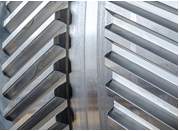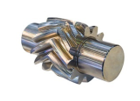Different Types of Gear
Gears are everywhere. They are used in electronics at home, commercial establishments, air conditioning, industries, and vehicles among other areas. A gear has three core functions: increasing torque, reducing speed generated from a motor, and changing the direction of torque. Gears can be classified by looking at the position of the axis such as parallel shafts, intersecting shafts, and non-intersecting shafts. Here is a closer look at the different types of gears:
Spur Gear

This group of gears helps to transmit power through shafts that are aligned in a parallel manner. The teeth of the spur gears are cut parallel to the shaft axis. This means that they produce radial motion loads on the shaft as opposed to axial loads.
When compared to others, spur gears are noisier because they operate using a single line of contact between their teeth. As the teeth run via the mesh, they roll off contact with one tooth and accelerate to roll with the next tooth.
Helical Gear
 These gears have their teeth cut at an angle to the main shaft. This implies that at one moment, more than one tooth will be in contact. When compared to the spur gears, the helical gears are able to carry a heavier load.
These gears have their teeth cut at an angle to the main shaft. This implies that at one moment, more than one tooth will be in contact. When compared to the spur gears, the helical gears are able to carry a heavier load.
Because more teeth are in contact when the gears are running, their operations are smooth and quiet. The helical gears generate thrust load that should be factored when using them. Today, most enclosed gears use the helical model.
Double Helical Gear
 These gears are a variation of the helical model in that they have two helical faces positioned next to each other but with a gap between them. Each face of the gear have identical, but opposite facing helix angles. When the double helical gears are used, they eliminate thrust loads and provide the possibility of more tooth overlap. They also guarantee smoother operation compared to helical and spur gears. These gears are mainly used in enclosed gear drives.
These gears are a variation of the helical model in that they have two helical faces positioned next to each other but with a gap between them. Each face of the gear have identical, but opposite facing helix angles. When the double helical gears are used, they eliminate thrust loads and provide the possibility of more tooth overlap. They also guarantee smoother operation compared to helical and spur gears. These gears are mainly used in enclosed gear drives.
Herringbone Gear
 These gears closely resemble the double helical gears but differ in that they lack a separating gap between the two faces. They are typically smaller compared to the double helical gears and are considered ideal for high vibration operations. Note that these gears are not common today because of their manufacturing difficulties and cost.
These gears closely resemble the double helical gears but differ in that they lack a separating gap between the two faces. They are typically smaller compared to the double helical gears and are considered ideal for high vibration operations. Note that these gears are not common today because of their manufacturing difficulties and cost.
Bevel Gear
 These gears are commonly used to transmit torque between shafts intersecting at right angles. They are more expensive compared to others such as the helical. Besides, they are not able to transmit a lot of torque compared to other gears such as the double helical models. Good examples of bevel gears are the hand drills, printing machines, and cooling towers.
These gears are commonly used to transmit torque between shafts intersecting at right angles. They are more expensive compared to others such as the helical. Besides, they are not able to transmit a lot of torque compared to other gears such as the double helical models. Good examples of bevel gears are the hand drills, printing machines, and cooling towers.
Worm Gear
These gears transmit power via right angles but on non-intersecting shafts. They generate thrust and are considered good for high shock load applications. However, their efficiency is relatively low compared to other gears such as the double helical models. Because of this disadvantage, they are mainly used in low horsepower applications.
If your application requires the use of gears, it is prudent to understand the different types and only select the one that guarantees higher efficiency. This post provides the main types of gears to help you identify the model that is compatible with your system and that guarantees higher efficiency. Remember to also ensure they are installed correctly for proper performance.
